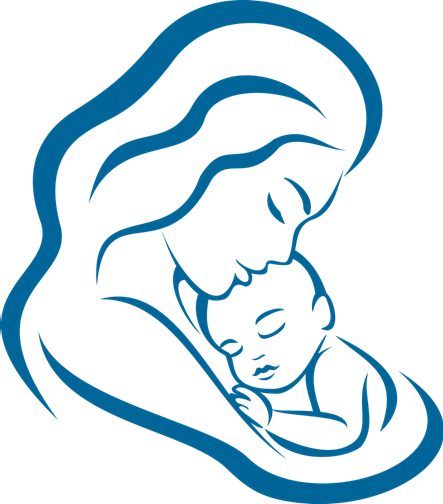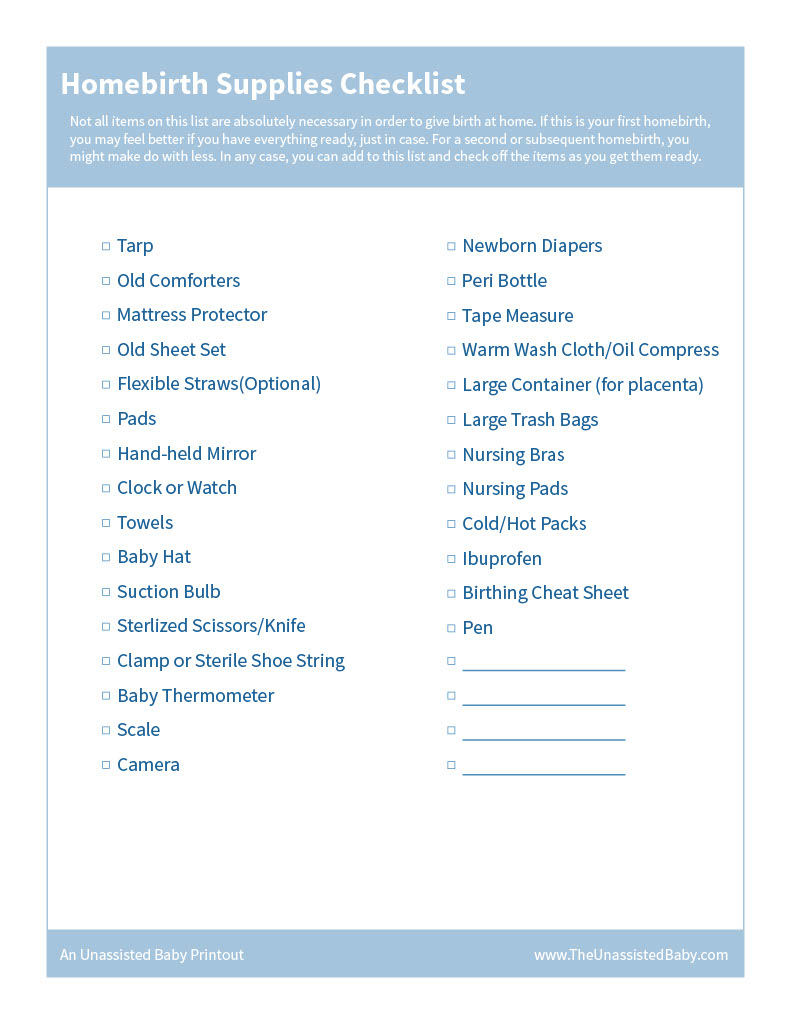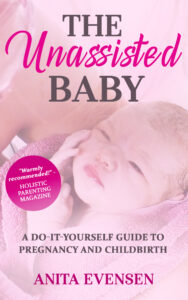How Do You Prepare for a Homebirth?
While you don’t need anything to give birth naturally, most women like to have a few things handy for when the baby comes. Whether you decide just to stock up on clean towels and something to cover your flooring with or purchase a full birth supply kit is completely up to you.
Homebirth preparation include everything from buying the supplies, knowing how to use them when the time comes, and getting your home ready for your baby. Another part of preparing for a home birth is to decide who your birth attendants will be (if any). Finally, you need to prepare yourself mentally for the birth and caring for a newborn.
An unassisted childbirth doesn’t mean you have to give birth alone. Giving birth unassisted means you don’t choose your attendants based on their medical experience. Instead, you get to give birth quietly at home with your partner or surrounded by caring and loving family members.
Before the big day comes closer, it’s a good idea to prepare yourself mentally. For example, you’ll want to research when it’s a good idea to call for medical assistance and what needs to happen during and after childbirth.
Why You Should Choose Your Birth Attendants Carefully
Numerous studies have shown that it makes a big difference to the laboring woman whether she has supportive birth attendants or not. For example, continuous support throughout labor greatly decreases the chance of a C-Section. However, most women don’t actually choose their birth attendants.
They may choose their doctor, but the doctor normally doesn’t show up until you’re ready to give birth. In the meantime, the laboring woman is being cared for by a rotating staff of nurses. If you’re lucky, they’re supportive of what you want. If not, then your birth won’t be as rewarding as it could have been.
It’s time for women to choose their birth attendants. That doesn’t mean that you have to give birth at home, especially if you need the assistance of a doctor. You can still invite supportive people to your birth who can remain with you at all times, whether that’s a doula, the father, or a close friend of yours. But it’s important for them to know what you want ahead of time, so they can help you.
Of course, it’s easier to have the kind of birth you want when you change the provider, the location, or both. Midwives tend to be more supportive of natural births, especially the ones that work at a birth center or at homebirths. However, even if you have to choose a hospital birth for whatever reason, you can still be in charge of your birth. You just have to work a little harder for it.
Of course, you don’t have to have any birth attendants at all if you don’t want to. You can give birth at home, unassisted. There is no need for medical intervention in most natural births. That’s why a growing number of women choose to give birth that way.
Of course, a lot of them still have supportive birth attendants, usually their partners or other family members. Just because they don’t hold a medical degree or certificate of some kind doesn’t mean they make bad birth attendants.
Setting the Stage of Easy Cleanup after Birth
Giving birth isn’t difficult. But if you want to give birth unassisted, you also have to think about the mess that comes with childbirth. Obviously, there will be some blood and gore. But guess what? Messes will become normal to you once you have children.
To make cleanup easier, try to contain the mess. That means you will pick an area for labor and delivery ahead of time. If you want to give birth in a tub, you might still want to have another area set up for afterwards.
For minimal cleanup, get a few things to protect your floors. While blood stains can be cleaned out easily just using cold water, it would be better not to have to scrub the carpet or floors. Therefore, consider purchasing or finding:
- a tarp to protect the floor (can be painter’s tarp, or a plastic tarp used for outdoor stuff)
- an old comforter or blankets to put over the tarp (because you want to give birth on something that feels nice than a tarp)
- large, disposable pads to line your bed or the floor with
- black trash bags to get rid of the evidence
Now here is where you’ll have to compromise between being environmentally friendly and making cleanup easy. If you’re so inclined, you can certainly clean the bedding and tarps up afterwards. But keep in mind you will need rest after giving birth, and your partner may not be as enthusiastic about taking care of these things. Therefore, the easiest thing is to use old blankets that you wanted to get rid of anyway.
For giving birth in a tub, you don’t have to do much. A tub can be drained and cleaned easily afterwards. However, you should line the way from your bed to the bathroom and tub with protective covering if you don’t want to end up scrubbing the floors later.
Childbirth will be messy, but the mess is definitely not a reason to give up on an unassisted birth. On the contrary, you can contain it and clean it up pretty easily.

What Supplies You Need for an Unassisted Homebirth
When women plan their homebirth, they often end up getting a supply kit of some kind or another. When they don’t find a kit, they’ll usually use someone else’s recommendations of what will be needed at the birth. You can keep it simple, or you can make it really complicated when it comes to homebirth supplies. However, you should remember this:
Nothing is mandatory. The only thing truly necessary for a successful homebirth is a woman in labor.
Of course, your chances of a happy outcome are greatly increased when the mother is very healthy and has faith in her body and the birthing process. And while a little extra knowledge won’t hurt, it’s not technically needed.
That being said, it doesn’t hurt to have a few supplies on hand. You might want to have one or more of the following things:
- plenty of towels
- an old blanket or tarp to cover up the floor
- old sheets
- sterilized scissors or knife
- pads
- suction bulb (just in case)
- clamp or sterilized shoe string (to tie off the cord)
- baby thermometer
- Peri bottle
- tape measure
- scale
- large trash bag
When you look at this list, it might seem huge. But you probably already have most of these items anyway, especially extra sheets, scissors, and some shoe string. For the things you don’t have, you just need to think about their uses.
For example, a Peri bottle is just a squirt bottle that will help relieve some pain while you’re on the toilet. And while you may not have an infant scale, there are other ways to weigh a baby. Plus, weighing your baby is certainly not the first priority during a homebirth, anyway.
One thing that doesn’t show up on my list are herbal remedies for possible problems. For example, many homebirth kits will include herbal remedies for postpartum hemorrhage. It’s totally up to you whether you want to have something like that available or not.
Freebirthers are no different from regular homebirthers when it comes to homebirth supplies. It may help you to have a supply list to make preparations. You don’t really need much of anything to give birth. Once your baby is born, all he or she needs from you is some skin to skin, colostrum, and lots of love.
Nevertheless, most people feel better prepared if they have a few basics on hand. If you’re a minimalist, then all you might want to prepare for your homebirth is a few extra towels. On the other end of the spectrum, some women feel more comfortable if they have everything on hand, including herbs to treat postpartum hemorrhage.
Where Can You Find Homebirth Supplies?
If you’re planning on giving birth at home, whether you do that as part of an unassisted birth or with the help of a midwife, you’ll inevitably start thinking about finding the necessary homebirth supplies. Besides wondering about what supplies you actually need, you might be concerned with where to find those supplies. Obviously, it all depends on what supplies you want to have, and which ones you don’t need.
Find Out What You Need
You can purchase homebirth supplies as part of a birth kit. Many midwives may even sell these to you or refer you to a place that sells them. However, homebirth supply kits often include too many things that you don’t actually need, for example, surgical gloves. Of course, if a midwife is going to assist you at your birth, then you need to honor the list she gives you.
Otherwise, it makes more sense to figure out what you need and where to get each individual item. Your list of homebirth supplies may be very short and basic, but it may also be elaborate. Just as with purchasing things for your baby’s first year of life, you have the choice to purchase essentials only or everything that’s out there, including things you may never end up using.
Cover the Essentials
By the way, if you want to make it really easy on yourself, all you really need is a few towels, something to cut the cord with (a pair of scissors or a knife), and something to tie the cord off with later (a shoelace). You probably already have all these things at home.
Before you go into labor, you may want to clean them, wash them, and/or sterilize them. Finally, you may want to find something to protect your flooring or bedding, for example, old comforters, blankets, and a tarp for underneath.
If you want to have more things on hand, such as a scale, umbilical cord scissors, a cord clamp, and other things like that, start your search early. You can buy almost anything online these days. In fact, all three of these things are sold by major retailers like Amazon. But if you also want to purchase herbs to take in case you hemorrhage, then you’ll need to do more research.
With homebirth supplies, you need to figure out what you want first. Then you can find a place to buy them from. But in case you don’t get everything in time, there is no reason to panic. Your baby doesn’t require anything fancy to be born.
Are You Interested in Having a Homebirth?
The Unassisted Baby is THE comprehensive guide every woman needs to give birth on her own. It includes information about prenatal care, pregnancy concerns, how to have a homebirth, a homebirth supply checklist, signs of labor, stages of labor and birth, potential complications, and even a guide for fathers. Get your copy of this invaluable resource today!


